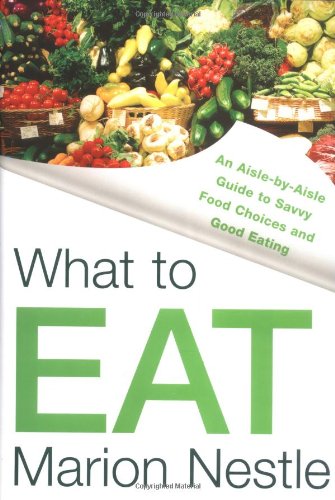 About: “What to Eat” is a book about how to make sensible food choices. Consider that today’s supermarket is ground zero for the food industry, a place where the giants of agribusiness compete for your purchases with profits—not health or nutrition—in mind. This book takes you on a guided tour of the supermarket, beginning in the produce section and continuing around the perimeter of the store to the dairy, meat, and fish counters, and then to the center aisles where you find the packaged foods, soft drinks, bottled waters, baby foods, and more. Along the way, it tells you just what you need to know about such matters as fresh and frozen, wild and farm-raised, organic and “natural,” and omega-3 and trans fats. It decodes food labels, nutrition and health claims, and portion sizes, and shows you how to balance decisions about food on the basis of freshness, taste, nutrition, and health, but also social and environmental issues and, of course, price.
About: “What to Eat” is a book about how to make sensible food choices. Consider that today’s supermarket is ground zero for the food industry, a place where the giants of agribusiness compete for your purchases with profits—not health or nutrition—in mind. This book takes you on a guided tour of the supermarket, beginning in the produce section and continuing around the perimeter of the store to the dairy, meat, and fish counters, and then to the center aisles where you find the packaged foods, soft drinks, bottled waters, baby foods, and more. Along the way, it tells you just what you need to know about such matters as fresh and frozen, wild and farm-raised, organic and “natural,” and omega-3 and trans fats. It decodes food labels, nutrition and health claims, and portion sizes, and shows you how to balance decisions about food on the basis of freshness, taste, nutrition, and health, but also social and environmental issues and, of course, price.
My thoughts: The most intelligent people are the ones who are able to convey their knowledge simply, which is exactly what Marion Nestle does in “What to Eat.” Her aisle by aisle guide was extremely informative and a pleasure to read. As someone who enjoys exploring grocery stores, her insights gave me a whole new set of nuances to notice.
I really enjoyed her purchasing recommendations for each aisle of the grocery store. One suggestion that I use often are her produce recommendations. Her preferences are:
- Organic and locally grown
- Organic and not local
- Locally grown and not organic
- Neither locally grown or organic
The concept of “food miles” (the miles/days/energy that foods travel to arrive at our grocery stores) was something I hardly paid attention to before, but now I make an effort to buy locally grown produce because they are fresher and more fuel efficient. So even though locally grown Jersey peaches are smaller in size than the ones from California, they are more nutritious and better for the environment.
Another aspect of the book that got me thinking was her take on advertising and the science behind the placement of products in stores – marketing and psychology are so fascinating!
This book is really long (611 pages), but is written so that you can seamlessly flip to a chapter that you’re interested in and skip the others. I only skimmed the chapters on coffees and teas because I never buy that stuff.
